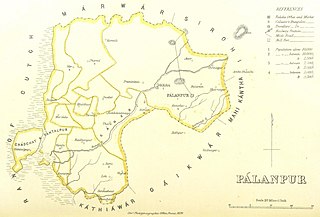Related Research Articles
Radhanpur is a town and a municipality in Patan district in the Indian state of Gujarat.
Kankrej thana or Kankrej Estates was a former collection of native states in what is now part of Banaskantha district of Gujarat, India.

Vav is a town and the headquarters of Vav Taluka in Patan district in Gujarat state of India. Vav is the largest taluka of the district.
Dinara is a village near Bhuj of Kutch district of Gujarat, India.
Morgar or Morgad is a village in Nakhatrana Taluka of Kutch district of Gujarat, India.
Rao Godji I was the Rao of Cutch belonging to the Jadeja Rajput dynasty, who ruled Princely State of Cutch from 1715 to 1718.
Ramas is a town and former Makwana Koli princely state in Mahi Kantha.

Radhanpur is a town and a municipality in Patan district in the Indian state of Gujarat. Radhanpur belonged to the Vaghelas in early years and later it was held as a fief under the Gujarat Sultanate by Fateh Khan Baloch. During Mughal period, the descendants of Babi dynasty were appointed as the governor of Radhanpur and other villages of North Gujarat. After decline of Mughal, they became free and established themselves as independent rulers. In 1743, Babi descendant Jawan Mard Khan II took over viceroyalty of Ahmedabad and controlled several villages in North Gujarat. He was defeated by Maratha Gaekwads in 1753 at Ahmedabad and Gaekwads agreed to his demand of control of villages in North Gujarat headquartered at Radhanpur State. His descendants lost some of these villages to Gaekwads subsequently. In 1813, Sher Khan made a treaty with the Gaekwar and British and became British protectorate. His descendants ruled the state until independence of India in 1947.
Santalpur is a village in Santalpur Taluka of Patan district of Gujarat state, India.
Varahi is a village in Santalpur taluka of Patan district of Gujarat state of India.
Suigam was a village in Vav Taluka of Maratha Riyasat in Gujarat, India, but it is now a Taluka of Banaskantha district in Gujarat.
Tervada is a village in Kankrej Taluka of Banaskantha district in Gujarat, India.
Morvada is a village in Vav Taluka of Banaskantha district in Gujarat, India.
Kakar is a village in Kankrej Taluka of Banaskantha district in Gujarat, India.
Mujpur, also spelled Munjpur is a village in Sankheshwar Taluka of Patan district in Gujarat, India.
Panchasar is a village in Shankheshwar Taluka of Patan district of Gujarat, India.
Sami is a town in Sami Taluka of Patan district of Gujarat, India.
Vaghel is a village in Harij Taluka of Patan district in Gujarat, India.

Chadchat is a region surrounding Santalpur in Patan district of Gujarat, India.
Jagana is a village in the Palanpur taluka of Banaskantha district in northern Gujarat, India. The villages Vasna, Bhagal, Sedrasana are located near to Jagana and it is just 6 km away from the district headquarters, Palanpur.
References
Notes
- ↑ "sandesh.com". Sandesh Gujarati Newspaper (in Gujarati). 7 May 2015. Archived from the original on 4 March 2016. Retrieved 26 December 2015.
- ↑ Gazetteer of the Bombay Presidency: Cutch, Palanpur, and Mahi Kantha 1880, p. 358-359.
Bibliography
- Gazetteer of the Bombay Presidency: Cutch, Palanpur, and Mahi Kantha. Government Central Press. 1880. p. 337.
![]() This article incorporates text from a publication now in the public domain: Gazetteer of the Bombay Presidency: Cutch, Palanpur, and Mahi Kantha. Government Central Press. 1880. p. 337.
This article incorporates text from a publication now in the public domain: Gazetteer of the Bombay Presidency: Cutch, Palanpur, and Mahi Kantha. Government Central Press. 1880. p. 337.